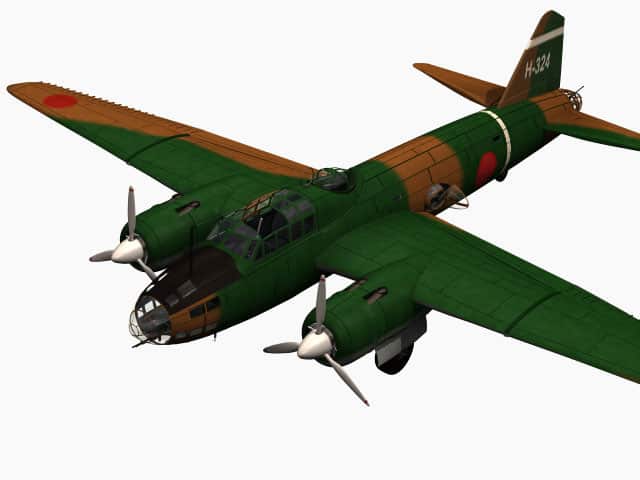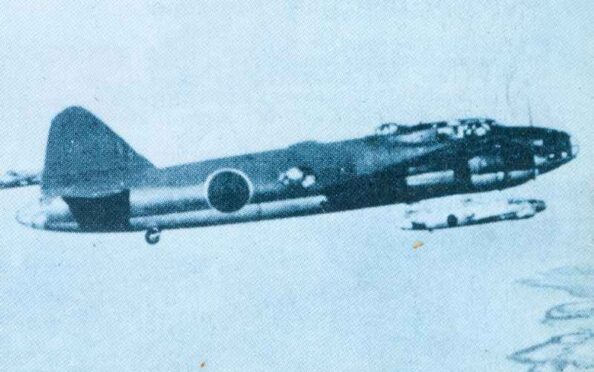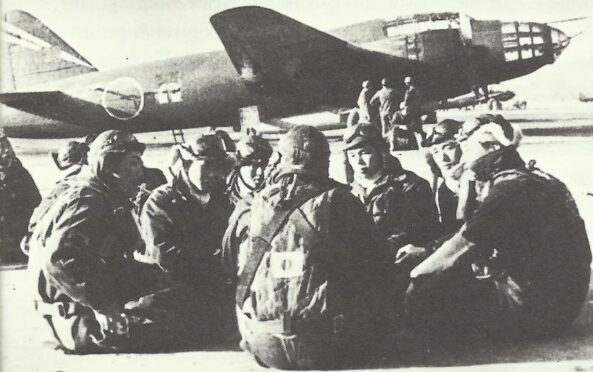Japanese medium and torpedo bomber Mitsubishi G4M Betty.
History, development, service, specifications, pictures and 3D model.

Mitsubishi G4M Betty G4M1 to G4M3c and G6M.
Type: Japanese land-based naval torpedo bomber and missile carrier.
History:
Table of Contents
Nicknamed the ‘Flying Cigar’ on account of its shape and because the fuel tanks were unprotected and easily caught fire, the Mitsubishi G4M was nevertheless the most famous and most numerous Japanese bomber of the war. A total of 2,446 were built in several versions between September 1939 and August 1945. The aircraft saw service from the first day of the war to the last, when two white-painted G4M1s, bearing green surrender crosses instead of the Rising Sun, carried the Japanese delegation to its final appointment with the Allies. The ‘Betty’, as the Mitsubishi bomber was called in the Allied code, proved itself an excellent combat aircraft on all fronts. Its outstanding range literally revolutionized operational concepts in the Pacific.
The G4M series was begun late in 1937 at the request of the Japanese Navy, which wanted a land-based bomber that was even better than the excellent G3M then entering service. High speed and long range were the chief requirements. The new aircraft was to reach a speed of 250 mph (400 km/h) at 10,000 ft (3,000 m), have a range of 3,000 miles (4,800 km) without payload and 2,300 miles (3,700 km) with a 1,760-pound (800 kg) torpedo. Designer Kiro Honjo solved the problems involved with great skill. The first of two prototypes took to the air for the first time on October 23, 1939.
Only a few minor changes were required, and during flight tests the aircraft easily met the specifications. The second prototype touched 278 mph (445 km/h) and demonstrated a range of more than 3,400 miles (5,500 km).
Before the bomber went into production, attempts were made to develop a heavy escort fighter version of the G4M1. Mass production of the bomber began in 1940, and the first examples came off the production line in April 1941. The Mitsubishi Betty made its operational debut in the last phases of the war against China, and when Japan and America went to war the G4M1 had a great weight of operational experience behind it. This expertise and the type’s long range were responsible for its great success, particularly during the first year of the war in the Pacific. G4Ms played a major role in the sinking of the British battleships Prince of Wales and Repulse on December 10, 1941.
Combat experience and the discovery of weak points such as a lack of armor led to the development of a more powerful and improved version in 1942. This was the G4M2, of which a total of 1,154 were built. The final version, the G4M3, appeared late in 1944. Only 60 of this variant were built.
Users: Japan (Imperial Navy).
Pictures Mitsubishi G4M Betty
Specifications Mitsubishi G4M1 Betty
Specifications:
Mitsubishi G4M1 Betty | Specification |
|---|---|
Type | land-based naval torpedo bomber |
Power plant | 2 x 1,530hp Mitsubishi Kasei 11 14-cylinder two-row radials |
Accommodation | 7 |
Wing span | 81ft 7.75in |
Length overall | 65ft 6.25in |
Height overall | 16ft 1in |
Weight empty | 14,860lb |
Weight loaded | 20,994lb |
Weight overload | 28,350lb |
Max level speed | 265 mph |
Initial climb | 1,800ft/min |
Service ceiling | 30,000 ft |
Range (with bombs at overload weight) | 3,132 miles |
Armament:
Mitsubishi G4M1 Betty | Specification |
|---|---|
in nose | 1 x manually aimed 7.7mm MG |
dorsal positon | 1 x manually aimed 7.7mm MG |
ventral position | 1 x manually aimed 7.7mm MG |
in tail | 1 x manually aimed 20mm gun |
internal bomb load | 2,205lb or 1,764lb torpedo externally |
Service statistics:
Mitsubishi G4M Betty | figures |
|---|---|
First flight | October 1939 |
Service delivery | April 1941 |
Total production figure (all) | 2,446 |
Animated 3D model Mitsubishi G4M Betty
References and literature
Combat Aircraft of World War II (Bill Gunston)
Technik und Einsatz der Kampfflugzeuge vom 1. Weltkrieg bis heute (Ian Parsons)
Das große Buch der Luftkämpfe (Ian Parsons)
Luftkrieg (Piekalkiewicz)
Flugzeuge des 2. Weltkrieges (Andrew Kershaw)
World Aircraft World War II (Enzo Angelucci, Paolo Matricardi)










